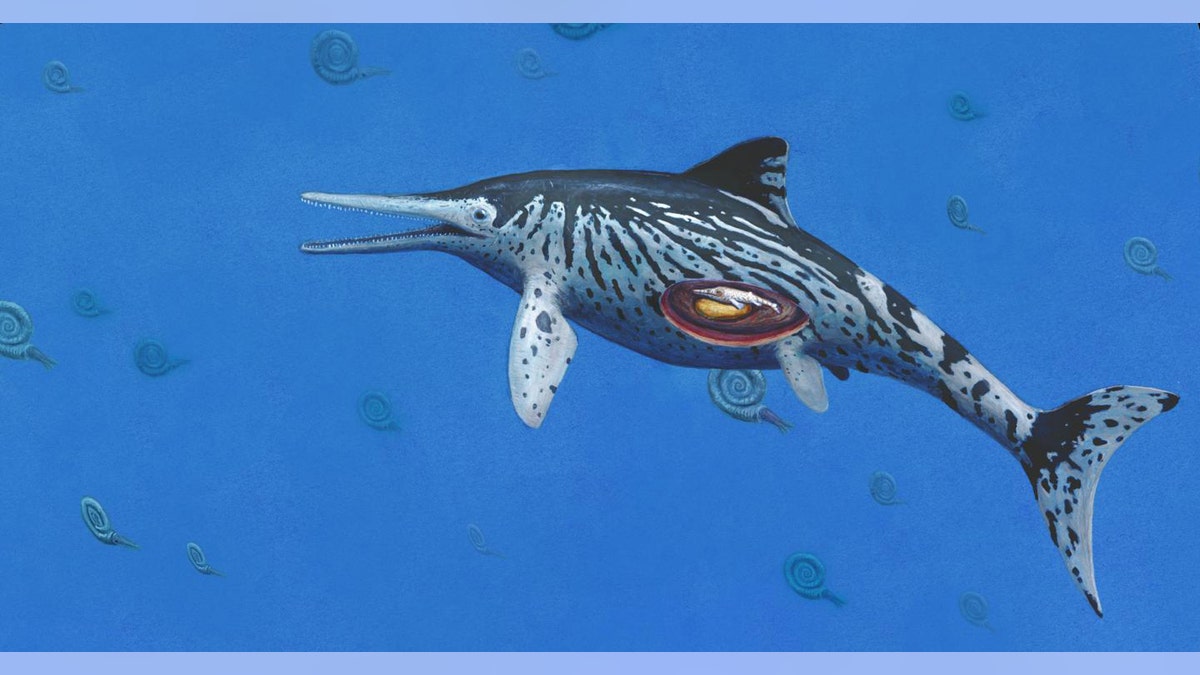
ARTIST IMPRESSION OF PREGNANT ICHTHYOSAURUS. (CREDIT: COPYRIGHT OF JOSCHUA KNÜPPE)
An almost complete fossil of the giant ‘lizard fish’ Ichthyosaur has been unearthed in India.
It’s the first time the 150-million-year-old fishlike reptile has been found on the sub continent.

(Prasad et al., 2017; Guntupalli Prasad)
At 5.5m long, this Jurassic-era sea monster doesn’t top the Ichthyosaur scales. Adults of the sleek, dolphin-like creature appear to have ranged in size from about 4.5m through to an enormous 9m.
But it is revealing. It’s very old. It was found among the remains of its prey. And it was found in India.
And new Australian research into some remarkably well preserved Ichthyosaur ‘cells’ in Germany provides new insight as to how these huge, lung-breathing beasts thrived in a low-oxygen atmosphere.
CRUNCHY LUNCH
The Ichthyosaur had large, strong teeth. And this one’s bones were embedded among fossilised ammonites and squid-like belemnites.
A close examination of the cracked, worn teeth shows the Ichthyosaur preferred crunchy food.
“We could infer from wear patterns on its teeth that this ichthyosaur was a top-tier predator that fed on hard and abrasive food material, including marine molluscs, fish and possibly other marine reptiles,” lead researcher Guntupalli Prasad said.
Details of the sea monster have been published in the journal PLOS ONE by the university of Delhi.
Ichthyosaur fossils have mostly been found in North America and Europe. A few have been uncovered in South America and Australia.
This one, found embedded in the very hard sedimentary rock of the Kachchh region of Gujarat, is almost complete.
After 1500 man-hours of excavation, only part of the skull and some of its tail bones were found to be missing. And its left forefin was remarkably well preserved in its original shape.
It appears to belong to the Ophthalmosauridae family of Ichthyosaurs, closely related to Northern Hemisphere varieties. It likely lived between 152 and 157 million years ago.
WORLDWIDE RANGE
The few other Ichthyosaur discoveries in India amount to just a few teeth or scattered vertebrate, and are some 50 million years younger than the new find.
At the time of its death, much of India was covered by a warm, tropical sea as the ancient supercontinent of Gondwanaland slowly began to break up.
Presad says Ichthyosaurs appeared to traverse a route linking modern-day India, Europe, Madagascar and South America.
“This is a remarkable discovery not only because it is the first Jurassic ichthyosaur record from India, but also it throws light on the evolution and diversity of ichthyosaurs in the Indo-Madagascan region of the former Gondwanaland and India’s biological connectivity with other continents in the Jurassic,” Presad writes.
“This find helps to show how globally widespread ichthyosaurs were during the time of dinosaurs,” University of Edinburgh palaeontologist Steve Brusatte told National Geographic. “They seem to have lived everywhere in the oceans, all over the world, at the same time dinosaurs were thundering across the land.”
OXYGEN OPTIMISATION
Curtin University professor Kliti Grice and PhD researcher Chloe Plet have published his research into the fossilised cell structure found in 183 million-year-old Early Jurassic ichthyosaur vertebra from Germany.
They found traces of red blood cells, collagen and cholesterol.
These were preserved as the fossil formed under carbonate concretion, a process where a carcass is trapped in an organic-matter rich environment with low oxygen conditions.
They also reveal how the lung-breathing creature coped with an Earth’s atmosphere containing much less oxygen than it does today.
“Ichthyosaurs evolved during a time when atmospheric oxygen levels were continuously low over a period of 70 million years,” Ms Plet says.
“During our analyses of the sample, we discovered red blood cell structures that were up to five times smaller than those reported in most modern organisms.
“We propose that small red blood cells were favourably produced by the species to provide efficient oxygen transport and diffusion. For example, modern-day mammals living at elevated altitudes with lower oxygen levels make small and abundant red blood cells.”
This story originally appeared in news.com.au.
